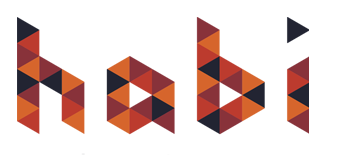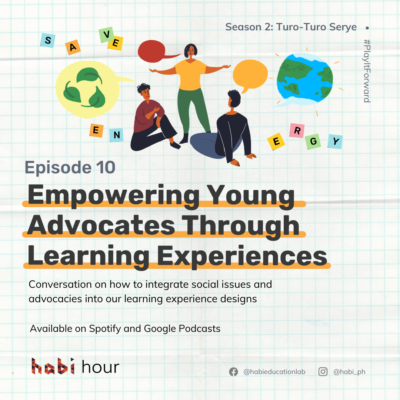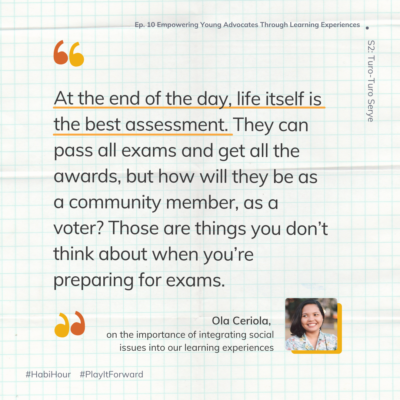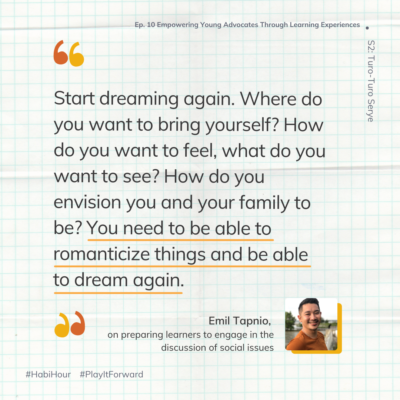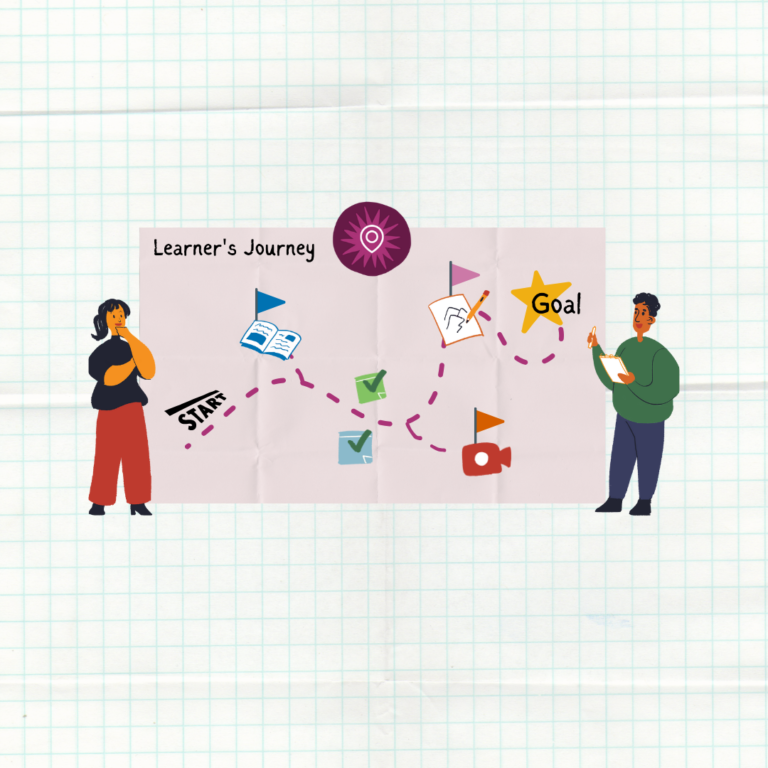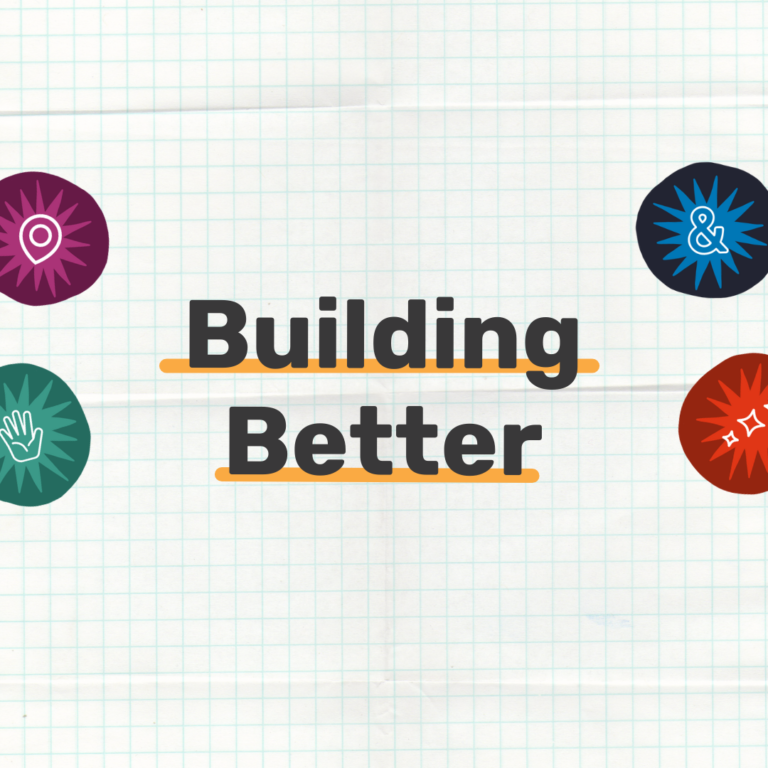Conversations on how to integrate social issues and advocacies into our learning experience design
Overview
11 June 2021 | 15 min and 55s
In this episode of our Turo-Turo Serye, we listen to Bea, Ola, and Emil share their stories on empowering young advocates through learning experiences. As the Philippines celebrates its 123rd Independence Day this June 12, let’s reflect on the different social issues that we are facing as a community, and see how each one of us (not just Social Studies teachers!) can design learning experiences for our students, colleagues, families, and friends that awaken critical and creative citizenship.
Transcript
OLA: It’s all about how we shape the lives of our learners and how they are able to carry it into the bigger picture, like in their families, in their communities, in our country.
ACH: Thank you. I think we can invite Tita Whitney to sing. Cue: Greatest Love of All.
[Ach and Ola laughs]
[Habi Hour Intro Spiel]
Introductions and Check In
ACH: Hei I’m Bea Ach, a Learning Experience Designer from Habi Education Lab. And I will be your emcee for this episode of Habi Hour.
[Habi Hour Intro Music]
ACH: Noong college pa ako, laging sinasabi ng mga mentors ko from my different student organizations na, “don’t let your schooling get in the way of your education.” Paradoxical as it may seem, for me it made sense kasi siyempre there’s always so much to learn outside the four walls of our classroom. Pero no’ng mas naging babad na ako sa education sector, na-realize ko na it doesn’t have to be mutually exclusive. Na oo, ang pag-aaral ay ibang iba sa edukasyon, pero hindi sila laging magkahiwalay. So for me the challenge now is, “how might we integrate these social issues, na supposedly real world experiences outside the classroom, into our learning experiences?”
At para mahimay natin itong challenge na ito, makakakuwentuhan natin ang isa kong kapwa LXD sa Habi at isa sa mga mentors na nabanggit ko nga kanina. Makakasama natin si Ola at si Kuya Emil.
OLA: Hi, I’m Paola. I’m a Learning Experience Designer at Habi Education Lab. And before joining the team, I was a TV producer, and I have done communications work for several non-profits.
EMIL: My name is Emil Tapnio. Isa akong development manager for over 15 years, ever since I graduated from the university. And ang larangan talaga na kinabibilangan ko, ay ever since university, ay development sector.
ACH: Let’s start with our usual check in. I’m curious to know, sa dinadami ng isyung panlipunan sa mundo ngayon, ano ‘yung masasabi n’yong very close to your heart?
OLA: One social issue that is really close to my heart is conversation. Ever since I graduated from college, ‘yun na ‘yung naging theme ng mga trabaho. For the longest time, it was really marine conservation. When we talk about marine conservation, it’s not just about the natural resources, but also the community who are part of it. Pumapasok doon ‘yung Local Government Units, Non-Profit organizations, pati ‘yung mga fisherfolk communities.
EMIL: It has always been human rights. Yes, napakalaki ng human rights as an issue, bilang usapin, pero lagi kong sinasabi na ‘yung human rights kasi, tuntungan s’ya ng iba-iba pang mga karapatan. My platform has always been human rights, pero may iba-ibang entry points s’ya, so right to education, right to decent living. ‘Yun ang ginagamit ko talagang tuntungan ever since. And it’s easy for me to wrap around kung bakit ko ginagawa ito kasi alam ko na ang karapatan ng mga mamamayang Pilipino na mabuhay nang maayos, for them to envision and lead a better life, doon pumapasok iyon sa basic human rights ng isang tao.
Kuwentuhan
ACH: Here we have an advocate for marine conversation and advocate for human rights. Paano kaya nila nai-integrate itong advocacies nila sa kanilang learning experiences?
OLA: When I was younger, wow younger [laughs], parang ang tanda ko na, di ba? Maybe 7 years ago, I started volunteering sa mga organizations. Some of there were Philippine Seas, Green Peace, then sasama ako sa mga workshops, so naging learning rin ako.
EMIL: Ever since I started working, talagang involved ako, una sa pag-implement lang hanggang sa mas natutunan ko kung paano mag-develop ng mga learning experiences for the youth. But I think more so sa current program that I’m currently handling at the Asia Foundation, it’s called Youth Leadership for Democracy. Talagang nakababad talaga, at nakaka-focus talaga sa mga kabataan. ‘Yung ginagawa namin at that time was promoting human rights as a concept. It was hard because it wasn’t sexy, but at the same time we thought it was a necessary thing.
OLA: Gumawa ako ng workshop for marine conservation. May mga lectures kami, may workshops kami. Nag-rent lang kami ng resort. May field trips kami. They actually went into the water and they learned how to skin dive. Nakita talaga nila what’s happening underwater, that there’s so many kinds of animals and plants underwater they they may just have seen in pictures or in documentaries. Iba talaga ‘yung kapag nakita mo s’ya face-to-face. Because when you look at the ocean it’s just vast and blue, but you don’t really see what’s underwater unless you actually go dive. ‘Yun ang ginawa ko. Wala pa akong kaalam-alam noon sa pedagogy or anything, as in clueless. Pero ang pinanghawakan ko na ang noon is my background in broadcasting communication and that is all about telling stories. Kinuwento ko lang sa kanila kung ano yung naroon. Why it is important for the Philippines, why it is important for society. And those things I learned from volunteering for other organizations also.
EMIL: It also started with us conducting human rights training sa iba’t ibang sangay ng gobyerno. In fact, we were also doing human rights training para sa mga atypical agencies like for example DOT, DTI. Lagi nilang sinasabi, “Bakit kay magte-training n’yan, eh hindi naman kami humaharap sa human rights? Sabi ko, “hindi.” Kaso for example, for DOT, we promote tourism, we talk to the hotel industry, to restaurants, you need to promote rights-based approach. Kasi how do you ensure for example na ‘yung mga papasok sa inyo na senior citizens or persons with disabilities, will be properly attended to by these businesses, di ba? Kung natural kasi sa’yo ang karapatang pantao at rights-based approach, normal mong iisipin na, “ah kailangan mong bigyan ng pagtangi ‘yung mga ganitong sektor.” Pero kung hindi, iisipin mo na, “Ay wala. Wala namang pera ‘to,” or “sagabal ito,” so uunahin mo muna ‘yung saan ka nakakakuha ng pera. How do you make human rights a natural thing for you as a person?
OLA: Kasi ako, naniniwala ako na when you are trying to convince someone, or when you are trying to discuss social issues, it shouldn’t intimidate them. It should be coming from where they are. Kasi kapag sinabi mo agad na, “Ok, let’s talk about marine conservation today,” and you talk about all the technicalities, tapos you start being very self-righteous about it, people will turn their backs and say, “Ay, ang self-righteous mo naman!” or “Ay, masyado namang intimidating itong topic na ‘to.” It’s all about meeting them where they are, what their interests are. What they enjoy.
EMIL: When you talk about Technopreneurship 101, for example when we go to different universities, for example my experiences going to Baguio, talking to St. Louis University, Baguio College Foundation, Benguet State University, we would always talk about, “Ano ba ‘yung problema dito sa arae n’yo?” Tapos sabi nila, “Mahirap Sir ‘yung pagtingin sa mga minahan kung kumusta ang toxicity nila para ‘yung mga minero namin hindi naman magkasakit.” So ang ginawa ko for example sa mga estudyante sa St. Louis University, when we were encouraging them, they actually created a man-made robot that goes in the mines, and chine-check n’ya ‘yung toxicity [ng mine]. So what they did was, out of that man-made robot, they actually created a business out of it. They started selling those robot-type things sa iba’t ibang mining companies, and that became an enterprise, a business of its own.
ACH: Pero siyempre may mga advocacies na sabihin na nating medyo controversial. So ito kayang mga learning experiences na may social issues, mayroon ba itong mga pushback from different people?
EMIL: Of course! [laughs] Totoo. Hindi mo kasi puwedeng basahin ‘yung entrepreneurship from the book at ituturo mo s’ya step-by-step. It doesn’t work that way. It has to be experiential, right? Understanding first kung ano ba talaga ‘yung need ng sector na ginagalawan mo. Hindi lang ‘yung punta ka lang, aura-aurada ka lang, “Gawin natin ‘to, guys.” Hindi gano’n. Hindi na uso ‘yung gano’n.
OLA: It wasn’t even about marine conservation. Mayroon kasing policy about jeepney drivers and they have to replace their jeeps with modern jeeps. May nag-comment sa post na ‘yun. And in fact, it was an article that my students wrote. May nag-comment na jeepney drivers are bad for traffic kasi daw hindi sila marunong mag-drive. It was hard to explain to that person kasi may trauma na s’yang naranasan in the past about vehicular accidents. Even if I was really fired up about it because I was so passionate about making him understand, it’s really hard to explain it to people, especially when it’s really personal, and they strongly believe that their perspective is the only perspective.
ACH: At this point, let’s hear their tips on how to empower young advocates through the learning experiences we design.
Tip number 1: Enable our learners to dream about the things they care about.
EMIL: Ang lagi kong sinasabi sa mga tine-train namin o sa sector na ginagalawan namin is for them to start dreaming again. Dream again. Bakit dream? Kasi kung halimbawa, hindi pa ready ang context, hindi mo kasi alam ang end point. But when you ask your sector, when you dream again, you kind of understand, you kind of imagine where you want to bring yourself. Saan mo s’ya dadalhin? Dreaming again. Para saan ‘yung ginagawa mo? Kasi kung masasagot mo ang mga ito, at malalaman mo ang end point mo, you can start working backwards. And from then on, you can start to plot what are the actions you need to do until the end point of your dream.
ACH: Tip number 2: Explore project-based learning.
OLA: Siguro one thing that learning designers or educators can use is project-based learning. With project- based learning, you go and find a real-world problem and you try to solve it within a certain amount of time. It’s not just a theoretical process like hindi lang sila nagbasa ng related literature or something, although that is also scientific. But they also interview real people. They gather data from the field. From there, you see the realities of it. You’re not just thinking about things in theory. Hindi mo lang iniisip ‘yung konsepto. Iniisip mo rin kung paano ito nangyayari sa mundo. At nakikita rin nila kung gaano kaimportante ‘yung natututunan nila sa classroom sa totoong buhay. I think as educators, ‘yun ang puwede nating gawin. Make our students and our learners realize that what they are learning in the classroom doesn’t end there.
ACH: Tip number 3: Maximize your sphere of influence.
EMIL: For those people with power, for those people na may say in power, it’s very important talaga that they should also b able to use that power, at least ‘yung sphere of influence nila, kung may mataas sila na kaalaman, they should use that to call to action para sa kanilang nasasakupan, sa kanilang constituents, sa kanilang sphere of influence, kasi it doesn’t make sense na sarili mo lang ang bibitbitin mo. Dapat may mas marami ka pang bitbit na tao.
ACH: And tip number 4: Be creative because talking about social issues can fall under any subject.
OLA: It is our responsibility to tell stories that our learners may not have known kung wala tayo, because some stories are under-represented. Some stories are not in our textbooks. There are people who aren’t heard. And whether you are a social studies teacher, or a science teacher, or even a math teacher, you have the opportunity to open up the world for your learners. If you are a science teacher, you can talk about the women in science. If you are a social studies teacher, or a history teacher, talk about our women heroes.
Life itself is the best assessment. Our learners can pass all the exams. They can ace all the exams. They can garner all the honors and awards. But at the end of the day, it’s really how they apply it in their lives. When they go out of the classroom, how are they going to be as a community member? What are they going to put forward. When they become voters, sino ang iboboto nila? Who are the ones who will be put into position when the time comes? Ano ‘yung mga policies na mapu-put forward?
ACH: Salamat uli kina Ola at Kuya Emil. Let me end by encouraging our educators to start by exploring what our learners are passionate about, o kung nasaan ang kiliti nila. Kasi when we design learning experiences around these, we give the message na itong mga isyung panlipunan, nasa labas man ito ng klasrum, hindi ito labas sa kanilang araw-araw na pamumuhay
[Habi Hour Outro Music]
